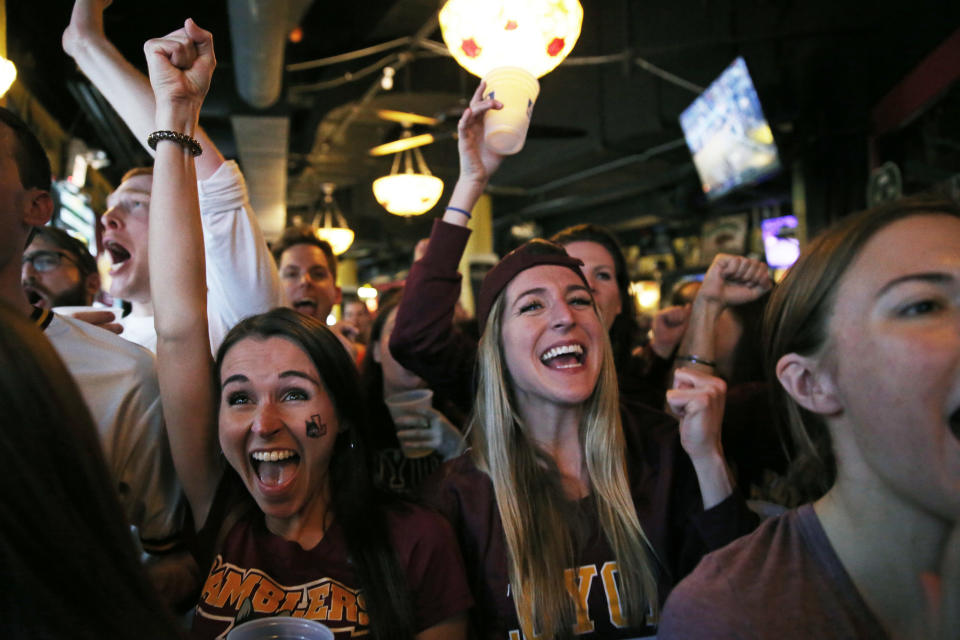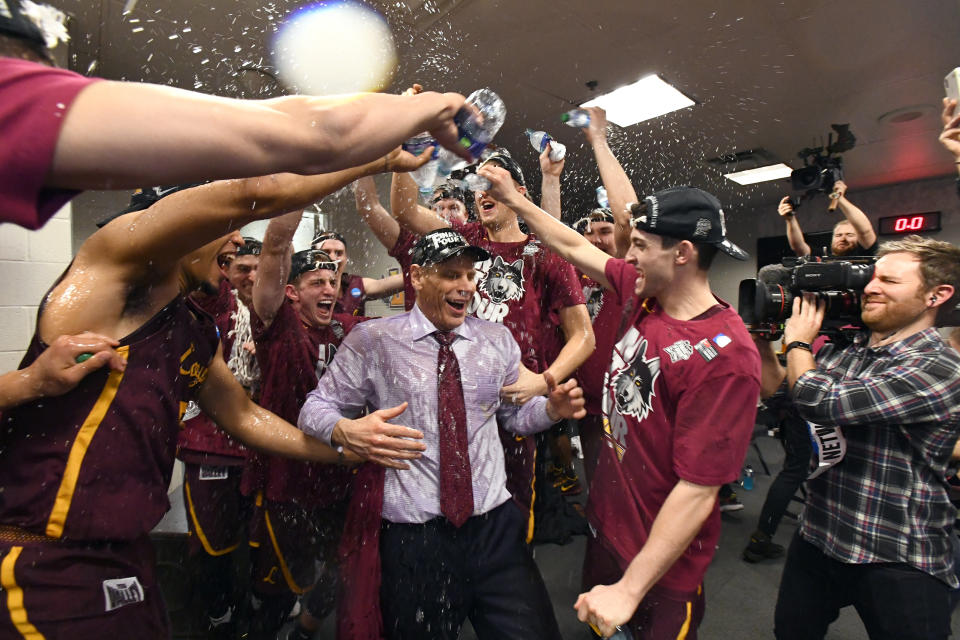Pandemonium, disbelief, and the Loyola Final Four run that even Loyola never dreamt of
CHICAGO — The staircase and its glass facing shook. Literally. Rattled by noise that transcended any definition of “ear-splitting.” Rattled by the piercing shrieks and joyous jumps and general pandemonium that accompanied a moment Loyola University will never forget.
They were rattled by students who never could have dreamt of this. Who never even considered the possibility that they’d be screaming maniacally during a basketball game in late March. Who two weeks ago, in some cases, didn’t even know what the words “Final Four” meant.
But at around 7:20 local time on Saturday night, those two words belted off walls in a jam-packed Damen Student Center. And they set off the party of a lifetime.
Hours earlier, those students had streamed in by the dozen, and then by the hundred, into the multipurpose campus hub where Loyola men’s basketball coach Porter Moser once handed out free hot dogs and t-shirts in an attempt to boost the team’s lagging attendance. And for two hours, they roared as that same basketball team did the unfathomable. They climbed on chairs and waved rally towels. They led coordinated chants. They hugged best friends and strangers with equal enthusiasm.
“This is the most school spirit I’ve ever seen,” one remarked amid the madness.

And then they filtered out into the night, across their lakeside campus in Rogers Park, up Sheridan Road, prancing uncontrollably, yelling incoherently, one crazed reveler flinging water up into the air in delight, just as Loyola players had done in Atlanta minutes earlier.
On the North Side of Chicago, there was something uniquely unscripted about the immediate aftermath of the Ramblers’ Final Four clincher. Something distinctly spontaneous. And all it takes to understand why is a quick dive into the program’s recent history.
* * * * *
Frank Biga has seen it all. Almost literally. A longtime Loyola fan with one undergraduate and two graduate degrees from the university, he attended every Rambler home game between 1973 and 1998. He’s been to the vast majority since. In other words – his own – “I’ve seen a lot of bad basketball.”
He saw precisely six winning seasons over the previous 30 years. It had been 33 since an NCAA tournament appearance. The school, he says, failed to capitalize on its run to the Sweet 16 in 1985, and “got left behind. We got left in the horse and buggy era, when everybody else was moving into race cars.”
He has stories upon stories to tell of the not-so-good old days. He remembers Alumni Gym, capacity 2,000, the team’s home until the late 1990s, where parts of the lower level only went back six rows, and where, at one point, “if you sat in the sixth row, you’d burn yourself on the radiator.” He recalls trying to purchase season tickets back in ’73, only to be met at the ticket window with confusion and a “We don’t do that.” He was given a specialized $10 punchcard instead.
He sat through 5-22 and 7-21 seasons, and even 7-23 in Moser’s first year. “We’ve had some good coaches who didn’t really have the resources to do the job,” he says. He used to tell friends that the Loyola stop on the red line of Chicago’s elevated public transit system, the “L,” stood for “loser.”
All of that is why this remarkable run has been so emotionally rewarding. “If you had been watching basketball for 40-some years and seen all the mediocrity we’ve seen, the success … is just like going to heaven,” Biga says. “It’s like winning the lottery. Like, Wow, I can’t believe this is really happening.”
In that sense, everything has changed. Moser, the players, and the university’s heightened commitment to athletics have changed it over the past few weeks.

But 33 barren years are a lot to overcome. Which is why, despite 24 wins and a CBI title in 2014-15, the 4,963-seat, recently renovated Gentile Arena was regularly less than half full. As one recent graduate says, “there were a dedicated few” at every game. But average attendance hovered around 1,800 for three consecutive seasons. Even this season, with wins piling up, it remained in the Missouri Valley basement.
And even this season, with wins piling up, most of the school’s approximately 11,000 undergraduates couldn’t have been coaxed into caring. At least two in the front row at Damen on Saturday had never been to a game. Moser had spoken passionately at freshman orientation back in the fall, one of his several attempts to drum up support, and some first-year students attended the season opener. Many, however, never returned.
After all, they hadn’t come to the well-regarded Jesuit university because of sports. They came, rather, for its diversity, or its strong academic programs, or its commitment to social justice initiatives.
None of them, therefore, ever envisioned that for a few magical weeks in March, that same school, their school, would temporarily become the center of the basketball universe.
And none of them ever envisaged the scene at the student center on Saturday. Not even in their wildest dreams.
* * * * *
The first seats were reserved before noon. The last were taken around three hours before tip. Students filing in with what they thought was an hour to spare were stunned to see the first floor already packed.
So they lined aisles and staircases and food court entrances and offices in their maroon and gold, and their Gryffindor-esque scarves. In shirts commemorating appearances in the Sweet 16 and the Elite Eight, every improbable step a milestone.

They told stories of how the NCAA tournament run has swept up the student body. Of classes cancelled and skipped. Of March Madness apps downloaded. Of ubiquitous hoops conversations in dining halls and lecture halls, in dorms and Ubers.
And then, for two hours, whether they had been to zero Ramblers games or dozens, whether they would recognize Ben Richardson on campus or they wouldn’t, they became some of the most rabid basketball fans on the plant. They greeted every bucket or defensive rebound with fist pumps and WOOOOOs and rapturous applause.
“I don’t know what the f— is happening to this school,” a disbelieving student said as the noise crescendoed to mirror Loyola’s ballooning lead.
Every free throw at Loyola pic.twitter.com/3fCv7N0V9U
— Henry Bushnell (@HenryBushnell) March 25, 2018
Out on the streets, there was relative silence. There were few signs that a basketball team was about to transform the university forever. Only one big banner recognizing the Missouri Valley championship and NCAA tournament appearance hinted at the possibility.
But inside Damen, a building wholly unprepared for the unprecedented party it was housing, the roar only grew. Sister Jean’s appearances on the broadcast turned it into an almost indescribable din. Perhaps the room didn’t actually shake as the final seconds of game clock ticked away. But if not, heads spun. And ears rung for hours thereafter.
Parties raged for even longer. As Damen emptied, those same streets that had earlier been eerily quiet began to fill. Students and alumni spilled out of campus bars. Horns honked both rhythmically and randomly, passersby egging them on.
And that banner? The one that boasted of a mere NCAA tournament appearance? It – along with so much else about the school and its identity – will need some updating.
– – – – – – –
Henry Bushnell covers soccer and college basketball for Yahoo Sports. Have a tip? Question? Comment? Email him at henrydbushnell@gmail.com or follow him on Twitter @HenryBushnell.



